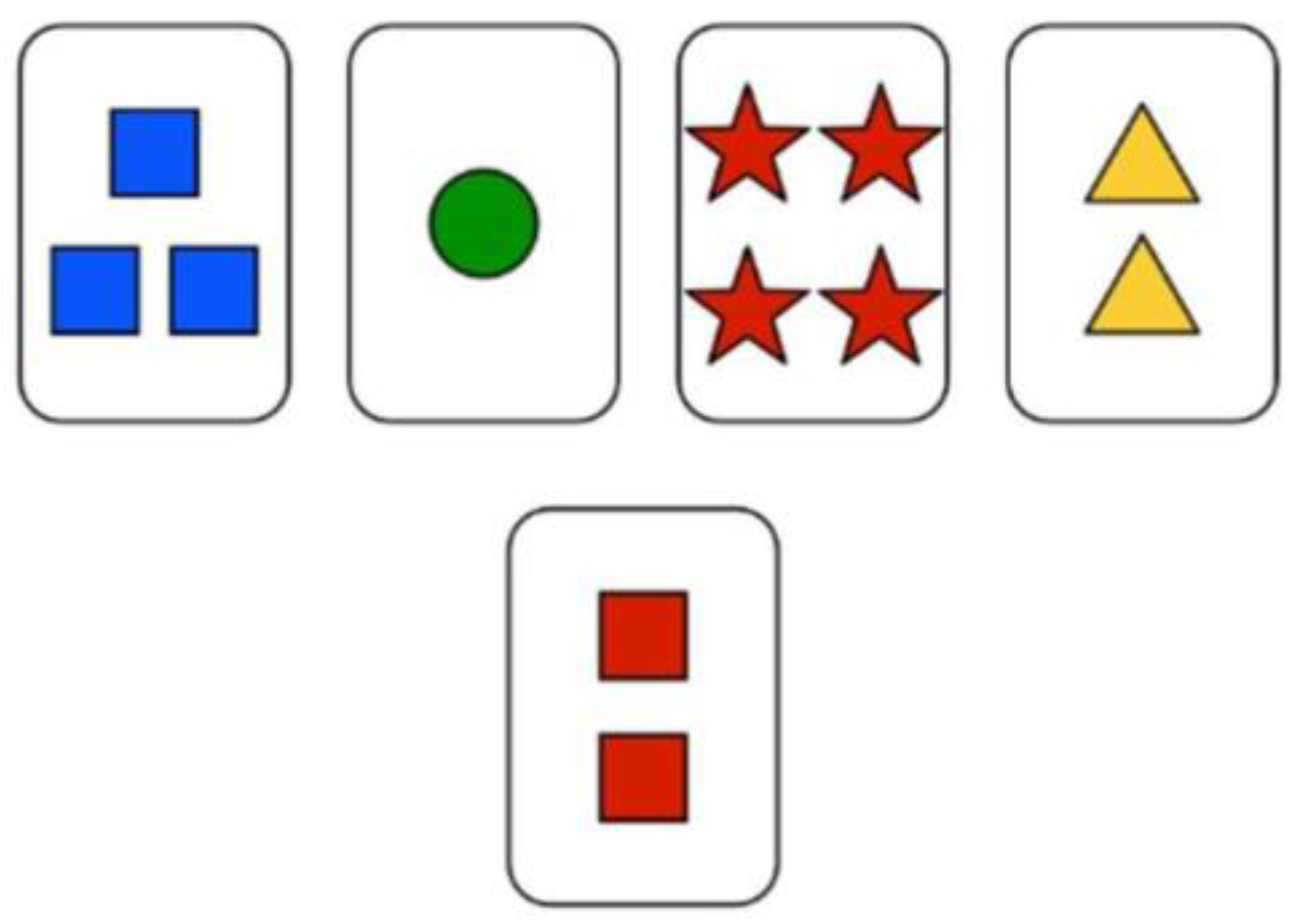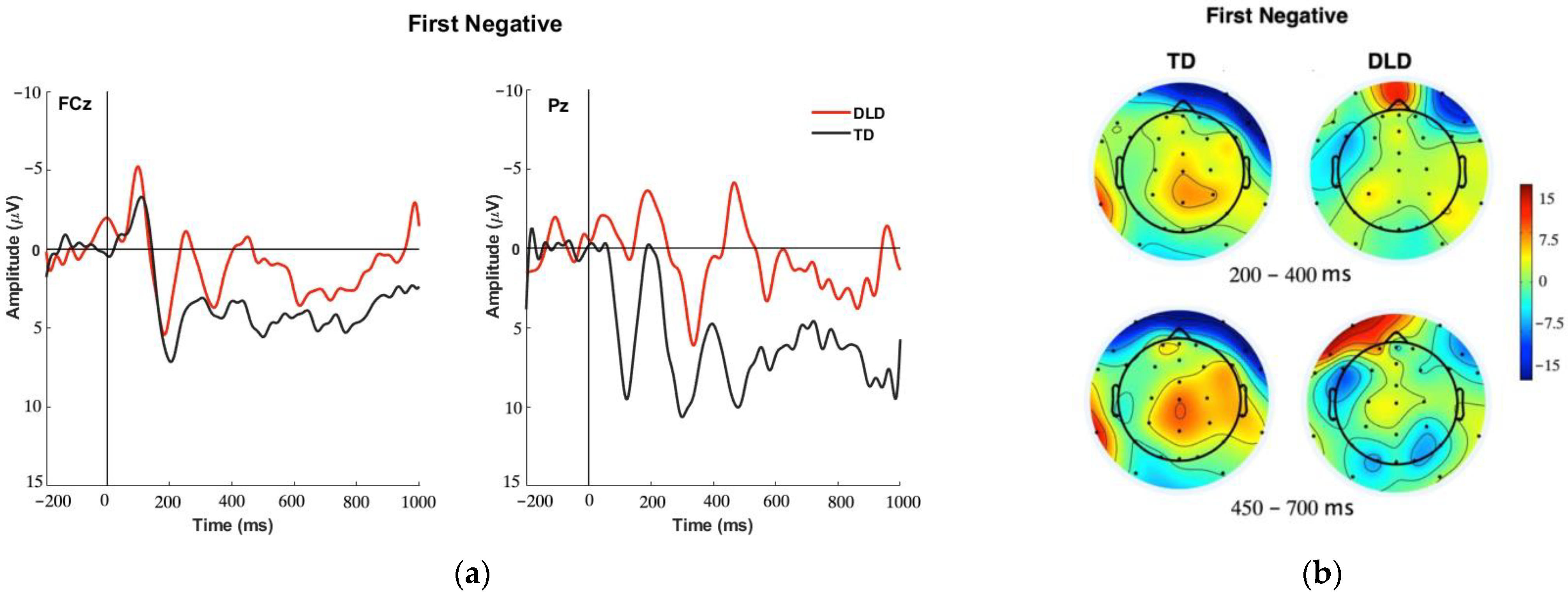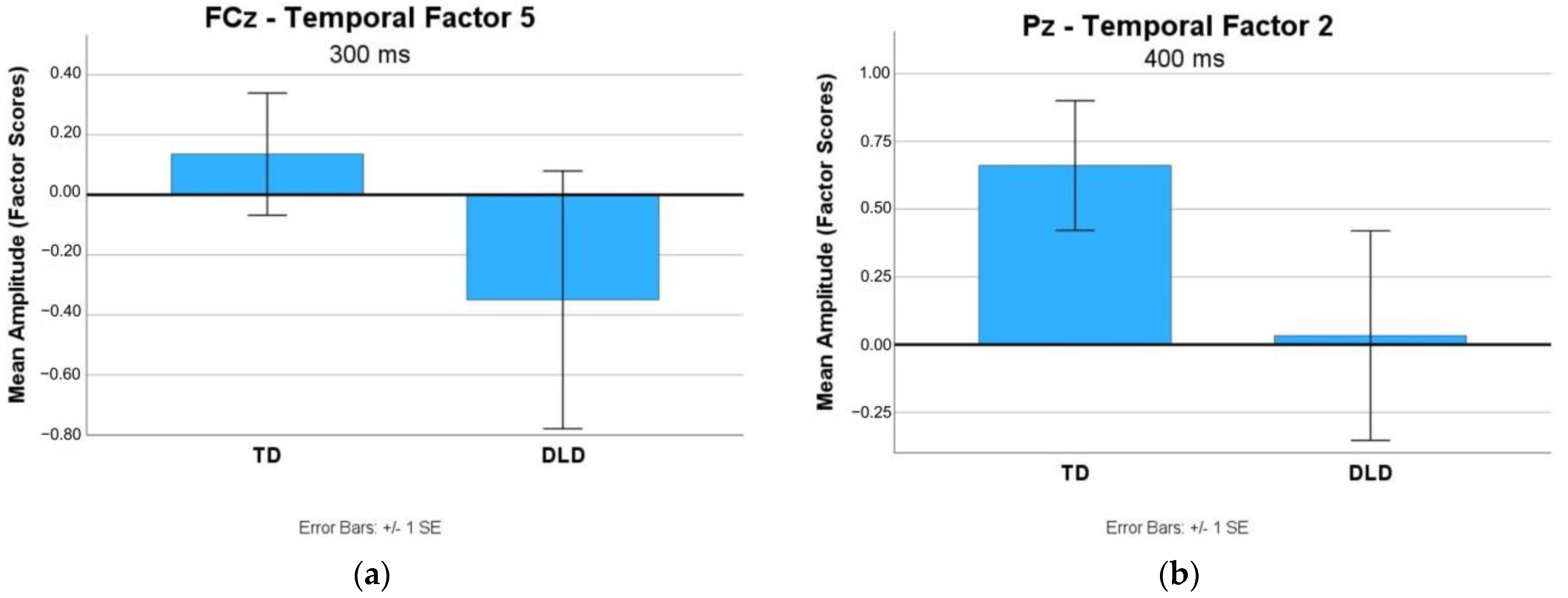Between Shifting and Feedback Processing in the Wisconsin Card Sorting Test in Children with Developmental Language Disorder
Abstract
1. Introduction
1.1. Literature Review
1.1.1. Unity and Diversity of EFs in Children with DLD
1.1.2. Wisconsin Card Sorting Test as a Test of EF
1.1.3. Event-Related Potentials and the WCST
1.1.4. WCST in Children with DLD
1.2. Research Aims and Questions
2. Materials and Methods
2.1. Task Procedure
2.2. Behavioral Data Analysis
2.3. EEG Data Acquisition and Analysis
3. Results
3.1. Behavioral Data
3.2. ERP Data
3.2.1. First Negative Feedback
3.2.2. First Positive versus Last Positive Feedback
3.2.3. Effective versus Ineffective Feedback
3.3. Regression Analyses
4. Discussion
4.1. Behavioral Outcomes of TD and DLD Participants
4.2. ERP Responses
4.3. Limitations and Future Directions
5. Conclusions
Author Contributions
Funding
Institutional Review Board Statement
Informed Consent Statement
Data Availability Statement
Acknowledgments
Conflicts of Interest
References
- Norbury, C.F.; Gooch, D.; Wray, C.; Baird, G.; Charman, T.; Simonoff, E.; Vamvakas, G.; Pickles, A. The impact of nonverbal ability on prevalence and clinical presentation of language disorder: Evidence from a population study. J. Child Psychol. Psychiatry 2016, 57, 1247–1257. [Google Scholar] [CrossRef]
- McGregor, K.K. How We Fail Children with Developmental Language Disorder. Lang. Speech Hear. Serv. Sch. 2020, 51, 981–992. [Google Scholar] [CrossRef]
- Kapa, L.L.; Plante, E. Executive Function in SLI: Recent Advances and Future Directions. Curr. Dev. Disord. Rep. 2015, 2, 245–252. [Google Scholar] [CrossRef]
- Pauls, L.J.; Archibald, L.M.D. Executive Functions in Children with Specific Language Impairment: A Meta-Analysis. J. Speech Lang. Hear. Res. 2016, 59, 1074–1096. [Google Scholar] [CrossRef]
- Blom, E.; Boerma, T. Do Children with Developmental Language Disorder (DLD) Have Difficulties with Interference Control, Visuospatial Working Memory, and Selective Attention? Developmental Patterns and the Role of Severity and Persistence of DLD. J. Speech Lang. Hear. Res. 2020, 63, 3036–3050. [Google Scholar] [CrossRef]
- Best, J.R.; Miller, P.H.; Jones, L.L. Executive functions after age 5: Changes and correlates. Dev. Rev. 2009, 29, 180–200. [Google Scholar] [CrossRef]
- Miyake, A.; Friedman, N.P.; Emerson, M.J.; Witzki, A.H.; Howerter, A.; Wager, T.D. The Unity and Diversity of Executive Functions and Their Contributions to Complex “Frontal Lobe” Tasks: A Latent Variable Analysis. Cogn. Psychol. 2000, 41, 49–100. [Google Scholar] [CrossRef]
- McCabe, D.P.; Roediger, H.L.; McDaniel, M.A.; Balota, D.A.; Hambrick, D.Z. The relationship between working memory capacity and executive functioning: Evidence for a common executive attention construct. Neuropsychology 2010, 24, 222–243. [Google Scholar] [CrossRef]
- Hughes, D.; Turkstra, L.; Wulfeck, B. Parent and self-ratings of executive function in adolescents with specific language impairment. Int. J. Lang. Commun. Disord. 2009, 44, 901–916. [Google Scholar] [CrossRef]
- Marton, K. Visuo-spatial processing and executive functions in children with specific language impairment. Int. J. Lang. Commun. Disord. 2008, 43, 181–200. [Google Scholar] [CrossRef]
- Weyandt, L.L.; Willis, W.G. Executive functions in school-aged children: Potential efficacy of tasks in discriminating clinical groups. Dev. Neuropsychol. 1994, 10, 27–38. [Google Scholar] [CrossRef]
- Yeniad, N.; Malda, M.; Mesman, J.; van Ijzendoorn, M.H.; Pieper, S. Shifting ability predicts math and reading performance in children: A meta-analytical study. Learn. Individ. Differ. 2013, 23, 1–9. [Google Scholar] [CrossRef]
- Aljahlan, Y.; Spaulding, T.J. Attentional shifting in children with developmental language disorder: A meta-analysis. J. Commun. Disord. 2021, 91, 106105. [Google Scholar] [CrossRef]
- Barceló, F.; Sanz, M.; Molina, V.; Rubia, F.J. The Wisconsin Card Sorting Test and the assessment of frontal function: A validation study with event-related potentials. Neuropsychologia 1997, 35, 399–408. [Google Scholar] [CrossRef]
- Barceló, F.; Knight, R.T. Both random and perseverative errors underlie WCST deficits in prefrontal patients. Neuropsychologia 2002, 40, 349–356. [Google Scholar] [CrossRef]
- Cunillera, T.; Fuentemilla, L.; Periañez, J.; Marco-Pallarès, J.; Krämer, U.M.; Càmara, E.; Münte, T.F.; Rodríguez-Fornells, A. Brain oscillatory activity associated with task switching and feedback processing. Cogn. Affect. Behav. Neurosci. 2011, 12, 16–33. [Google Scholar] [CrossRef]
- Arbel, Y.; Fox, A.B. Electrophysiological Examination of Feedback-Based Learning in 8–11-Year-Old Children. Front. Psychol. 2021, 12, 640270. [Google Scholar] [CrossRef]
- Arbel, Y.; Fitzpatrick, I.; He, X. Learning with and without Feedback in Children with Developmental Language Disorder. J. Speech Lang. Hear. Res. 2021, 64, 1696–1711. [Google Scholar] [CrossRef]
- Barceló, F. The Madrid card sorting test (MCST): A task switching paradigm to study executive attention with event-related potentials. Brain Res. Protoc. 2003, 11, 27–37. [Google Scholar] [CrossRef]
- Donchin, E.; Coles, M.G.H. Is the P300 component a manifestation of context updating? Behav. Brain Sci. 1988, 11, 357–374. [Google Scholar] [CrossRef]
- Miltner, W.H.R.; Braun, C.H.; Coles, M.G.H. Event-Related Brain Potentials following Incorrect Feedback in a Time-Estimation Task: Evidence for a “Generic” Neural System for Error Detection. J. Cogn. Neurosci. 1997, 9, 788–798. [Google Scholar] [CrossRef]
- Arbel, Y.; Goforth, K.; Donchin, E. The Good, the Bad, or the Useful? The Examination of the Relationship between the Feedback-related Negativity (FRN) and Long-term Learning Outcomes. J. Cogn. Neurosci. 2013, 25, 1249–1260. [Google Scholar] [CrossRef]
- Holroyd, C.B.; Coles, M.G.H. The neural basis of human error processing: Reinforcement learning, dopamine, and the error-related negativity. Psychol. Rev. 2002, 109, 679–709. [Google Scholar] [CrossRef]
- Horowitz-Kraus, T. Pinpointing the Deficit in Executive Functions in Adolescents with Dyslexia Performing the Wisconsin Card Sorting Test. J. Learn. Disabil. 2014, 47, 208–223. [Google Scholar] [CrossRef]
- Kraus, D.; Horowitz-Kraus, T. The Effect of Learning on Feedback-Related Potentials in Adolescents with Dyslexia: An EEG-ERP Study. PLoS ONE 2014, 9, e100486. [Google Scholar] [CrossRef]
- Nelson, N.W.; Plante, E.; Helm-Estabrooks, N.; Hotz, G. Test of Integrated Language and Literacy Skills (TILLS). Brookes: Baltimore, MD, USA, 2016. [Google Scholar]
- Kaufman, A.S.; Kaufman, N.L. Kaufman Brief Intelligence Test, Second Edition (KBIT-2); Pearson, Inc.: Bloomington, IN, USA, 2004. [Google Scholar]
- Semel, E.; Wiig, E.H.; Secord, W.A. Clinical Evaluation of Language Fundamentals, Fourth Edition. (CELF-4); Pearson, Inc.: Bloomington, IN, USA, 2003. [Google Scholar]
- Torgesen, J.K.; Rashotte, C.A.; Wagner, R.K. Test of Word Reading Efficiency, Second Edition (TOWRE-2); PRO-ED: Austin, TX, USA, 1999. [Google Scholar]
- Delorme, A.; Makeig, S. EEGLAB: An open-source toolbox for analysis of single-trial EEG dynamics including independent component analysis. J Neurosci Methods. 2004, 134, 9–21. [Google Scholar] [CrossRef]
- Gul, A.; Baron, L.; Arbel, Y. Feedback Processing During Probabilistic Learning in Children with Developmental Language Disorder: An Event-Related Potential Study. J. Speech Lang. Hear. Res. 2022, 56, 2272–2287. [Google Scholar] [CrossRef]
- Huizinga, M.; van der Molen, M.W. Age-group differences in set-switching and set-maintenance on the Wisconsin Card Sorting Task. Dev. Neuropsychol. 2007, 31, 193–215. [Google Scholar] [CrossRef]
- Li, F.; Wang, J.; Du, B.; Cao, B. Electrophysiological Response to the Informative Value of Feedback Revealed in a Segmented Wisconsin Card Sorting Test. Front. Psychol. 2018, 9, 57. [Google Scholar] [CrossRef]
- Arbel, Y.; McCarty, K.N.; Goldman, M.; Donchin, E.; Brumback, T. Developmental changes in the feedback related negativity from 8 to 14 years. Int. J. Psychophysiol. 2018, 132, 331–337. [Google Scholar] [CrossRef]
- Arbel, Y.; Murphy, A.; Donchin, E. On the Utility of Positive and Negative Feedback in a Paired-associate Learning Task. J. Cogn. Neurosci. 2014, 26, 1445–1453. [Google Scholar] [CrossRef]







| TD (n = 12) | DLD (n = 12) | One-Way ANOVA | ||||
|---|---|---|---|---|---|---|
| F | df | p | η2 | |||
| Age (months) | 115.47 (12.66) | 113.32 (11.51) | 0.19 | 22 | 0.67 | 0.009 |
| TILLS Identification Core Standard Score | 106.83 (11.73) | 68.75 (10.34) | 71.17 | 22 | <0.001 | 0.764 |
| KBIT-2 Nonverbal Standard Score | 109.75 (13.90) | 96.91 (11.60) | 6.03 | 22 | 0.02 | 0.215 |
| CELF-4 Working Memory Index Score | 102.33 (11.40) | 89.83 (12.31) | 6.66 | 22 | 0.02 | 0.232 |
| TOWRE-2 Total Standard Score | 109.00 (9.98) | 77.50 (17.12) | 30.31 | 22 | <0.001 | 0.579 |
| Chi-Square Test | ||||||
| χ2 | df | p | ||||
| Gender | 6 Male 6 Female | 6 Male 6 Female | 0.00 | 1 | 1.00 | |
| Measure | Definition |
|---|---|
| Accuracy | The proportion correct across all trials, excluding Switch and Switch 2 trials. |
| Sets Learned | The number of sets where participant responded with the correct rule on at least three consecutive trials (regardless of any other errors in this set) out of 19 total sets. |
| Trials to Learn Set | The average number of trials on which a participant established “learning criterion” (three consecutive correct responses) across all learned sets. Excludes Switch trial so that trial 1 of a set = Switch 2 trial. |
| Correct Shifts | The proportion of rule shifts where the participant finds the correct rule on either the Switch 2 and/or Switch 3 trial out of total rule shifts. Only includes rule shifts where the participant successfully learned the previous set and the participant did not “anticipate” the rule shift. |
| Perseverative Shift Errors | The proportion of rule shifts where the participant’s response on the Switch 2 and/or Switch 3 trials is made according to the rule of the previous set out of total Switch 2 and Switch 3 trials. Only rule shifts where the participant successfully learned the previous set. |
| Effective Negative Feedback Response | The number of negative feedback presentations that are followed by a change in the participant’s response (i.e., participant does not respond according to same rule that elicited negative feedback) as a proportion of the total instances of negative feedback. Excludes feedback events where the subsequent response is a “No Rule” response (i.e., button press does not map onto any of the rules). |
| Measure | TD (n = 12) | DLD (n = 12) | One-Way ANOVA | |||
|---|---|---|---|---|---|---|
| F | df | p | η2 | |||
| Accuracy | 0.85 (0.12) | 0.65 (0.13) | 14.31 | 22 | 0.001 | 0.394 |
| Sets Learned | 17.75 (1.96) | 14.25 (3.41) | 9.48 | 22 | 0.005 | 0.301 |
| Trials to Learn Set | 4.43 (0.68) | 4.89 (1.06) | 1.60 | 22 | 0.22 | 0.068 |
| Correct Shifts | 0.88 (0.20) | 0.71 (0.16) | 5.09 | 22 | 0.03 | 0.188 |
| Perseverative Shift Errors | 0.09 (0.10) | 0.21 (0.11) | 8.03 | 22 | 0.01 | 0.267 |
| Effective Negative Feedback Response | 0.89 (0.11) | 0.78 (0.08) | 8.43 | 22 | 0.008 | 0.277 |
| TD | DLD | ||||||
|---|---|---|---|---|---|---|---|
| Model | Beta | t | Sig. | Beta | t | Sig. | |
| Accuracy | First Positive P3b | −0.601 | −1.754 | 0.117 | −0.075 | −0.197 | 0.851 |
| Last Positive P3b | 0.840 | 2.452 | 0.040 | −0.432 | −1.127 | 0.303 | |
| F | 3.045 | 0.104 | 0.639 | 0.560 | |||
| Adj. R2 | 0.290 | −0.099 | |||||
| Correct Shifts | First Positive P3b | −0.703 | −2.793 | 0.023 | 0.560 | 1.724 | 0.135 |
| Last Positive P3b | 1.070 | 4.249 | 0.003 | −0.198 | −0.611 | 0.563 | |
| First Negative FRN * | 0.688 | 2.225 | 0.068 | 0.425 | 1.155 | 0.312 | |
| F | 9.039 | 0.009 | 2.072 | 0.207 | |||
| Adj. R2 | 0.617 | 0.211 | |||||
| Perseverative Shift Errors | First Positive P3b | 0.886 | 3.153 | 0.014 | 0.226 | 1.391 | 0.214 |
| Last Positive P3b | −0.934 | −3.323 | 0.010 | 0.954 | 5.868 | 0.001 | |
| F | 6.458 | 0.021 | 17.223 | 0.003 | |||
| Adj. R2 | 0.522 | 0.802 | |||||
Disclaimer/Publisher’s Note: The statements, opinions and data contained in all publications are solely those of the individual author(s) and contributor(s) and not of MDPI and/or the editor(s). MDPI and/or the editor(s) disclaim responsibility for any injury to people or property resulting from any ideas, methods, instructions or products referred to in the content. |
© 2023 by the authors. Licensee MDPI, Basel, Switzerland. This article is an open access article distributed under the terms and conditions of the Creative Commons Attribution (CC BY) license (https://creativecommons.org/licenses/by/4.0/).
Share and Cite
Giandomenico, K.; Baron, L.S.; Gul, A.; Arbel, Y. Between Shifting and Feedback Processing in the Wisconsin Card Sorting Test in Children with Developmental Language Disorder. Brain Sci. 2023, 13, 1128. https://doi.org/10.3390/brainsci13081128
Giandomenico K, Baron LS, Gul A, Arbel Y. Between Shifting and Feedback Processing in the Wisconsin Card Sorting Test in Children with Developmental Language Disorder. Brain Sciences. 2023; 13(8):1128. https://doi.org/10.3390/brainsci13081128
Chicago/Turabian StyleGiandomenico, Kristina, Lauren S. Baron, Asiya Gul, and Yael Arbel. 2023. "Between Shifting and Feedback Processing in the Wisconsin Card Sorting Test in Children with Developmental Language Disorder" Brain Sciences 13, no. 8: 1128. https://doi.org/10.3390/brainsci13081128
APA StyleGiandomenico, K., Baron, L. S., Gul, A., & Arbel, Y. (2023). Between Shifting and Feedback Processing in the Wisconsin Card Sorting Test in Children with Developmental Language Disorder. Brain Sciences, 13(8), 1128. https://doi.org/10.3390/brainsci13081128





